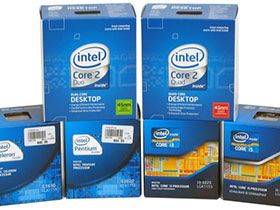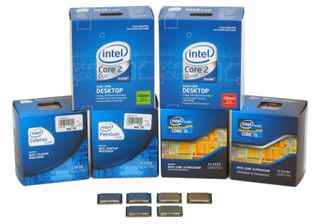Is This Even Fair? Budget Ivy Bridge Takes On Core 2 Duo And Quad
Reader requests affect much of the work we do, and we constantly receive email asking for this one: compare Intel's older Wolfdale- and Yorkfield-based designs against today's budget-friendly Ivy Bridge-based processors. Well, you asked, and we deliver.

Old Vs. New: Six Intel Processors, Benchmarked
Budget-oriented hardware doesn’t always receive its fair share of attention. In fact, most of the time, it's pretty difficult to get samples to review from companies like Intel and AMD, which don't want to see their lower-end hardware maligned. Thankfully, many of Intel’s newer Ivy Bridge-based models are fairly affordable, starting at a dirt-cheap $35. So, we stopped into our local Micro Center retail store and bought three CPUs to create today's comparison. And we chose to pit these newest Celeron, Pentium, and Core i3 chips against former favorites that no longer get dusted off for testing.

If you've spent much time reading Tom's Hardware, then you're probably very familiar with Intel's LGA 775 interface. In fact, if you built or bought a PC between 2006 and 2008, it probably sported a Core 2 Duo or Quad CPU that dropped into LGA 775. Perhaps, like me, you constructed a gaming rig to take on 2007's big hit, Crysis. This legendary Chuck Norris of PC games convinced me that my old single-core AMD Athlon 64 FX-55 gaming rig just wasn’t going to cut it any longer. Amidst the dual- versus quad-core debates, I jumped past Intel's Conroe-based Core 2 Duo and went straight to a Core 2 Quad Q6600 (Kentsfield) with a G0 stepping. Tamely overclocked to 3.0 GHz, this CPU is still a fixture in my home, even today.
Not long after, Intel adopted 45 nm manufacturing. Once Wofldale-based processors hit the mainstream scene, it was hard to argue against a highly-overclockable Core 2 Duo E8400 for gaming. On the flip side, many power users preferred the overall performance of newer quad-core models, such as the Yorkfield-based Core 2 Quad Q9550.
Unlike AMD’s Athlon II and Phenom II families, which are still available and show up in our stories, Intel's LGA 775 platform got shoved aside in favor of newer architectures, which became the first-, second-, and third-generation Core processors. Some of our readers noticed the absence of those LGA 775-based CPUs in our tests, though, and we agree that it's time to revisit their performance in a more modern benchmark suite. So, today's story is for anyone holding on to an older Core 2 platform (or anyone who enjoys comparisons to modern offerings five years later).
Wolfdale And Yorkfield Take On Ivy Bridge
Core 2 Duo E8400 and Core 2 Quad Q9550 delivered solid clock rates right out of the box, but they're also best remembered for their substantial overclocking headroom. It was easier to keep two cores cool, so the Duos tended to handle higher voltages better, scaling higher in the process. Chips like ours, based on the E0 stepping, hit frequencies 30 to 50% higher on air cooling. So, we weren’t about to shy away from overclocking in this piece. Of course, we’ve come to expect high efficiency and per-clock performance from Intel’s Ivy Bridge-based processors, but we also know this great performance steered Intel towards locking the multiplier ratios of its lower-end offerings, a slap in the face for many enthusiasts, and a huge blow to gamers on a tight budget. Might high frequencies propel Intel’s old Core 2 architecture up beyond the latest locked-down Ivy Bridge-based chips?
Because this piece centers on data, we’re eager to hit the performance charts. But first we should introduce today’s contenders. Our trio of dual-core chips includes the Celeron G1610, Pentium G2020, and Core 2 Duo E8400. The Core i3-3225, equipped with Intel’s Hyper-Threading technology, is the oddball of the bunch, sporting two physical cores capable of addressing two threads each. It goes up against the Core 2 Quad Q9550, armed with four physical cores. As a control, we also include the quad-core Core i5-3570K, a modern enthusiast favorite and the only chip we're testing considered a worthy upgrade to the Core 2 Quad.
Stay on the Cutting Edge
Join the experts who read Tom's Hardware for the inside track on enthusiast PC tech news — and have for over 25 years. We'll send breaking news and in-depth reviews of CPUs, GPUs, AI, maker hardware and more straight to your inbox.
| Cores / Threads | Intel LGA 1155 Interface | Intel LGA 775 Interface |
|---|---|---|
| 2 / 2 | Intel Celeron G1610 (Ivy Bridge), 22 nm, 2.6 GHz, 2 MB Shared L3, Launched Q1 2013, Box: $42 | Intel Core 2 Duo E8400 (Wolfdale), 45 nm, 3.0 GHz, 1,333 MT/s FSB, 6 MB L2 Cache, Launched Q1 2008, Box: $179 |
| Row 1 - Cell 0 | Intel Pentium G2020 (Ivy Bridge), 22 nm, 2.9 GHz, 3 MB Shared L3, Launched Q1 2013, Box: $64 | Row 1 - Cell 2 |
| 2 / 4 | Intel Core i3-3225 (Ivy Bridge), 22 nm, 3.3 GHz, 3 MB Shared L3, Hyper-Threading, Launched Q4 2012, Box: $134 | Row 2 - Cell 2 |
| 4 / 4 | Intel Core i5-3570K (Ivy Bridge), 22 nm, 3.4 GHz (3.8 GHz Turbo), 6 MB Shared L3, Launched Q2 2012, Box: $235 | Intel Core 2 Quad Q9550 (Yorkfield), 45 nm, 2.83 GHz, 1,333 MT/s FSB, 12 MB L2 Cache, Launched Q1 2008, Box: $287 |
If you want to refresh your knowledge of the architectures we're testing, have a look back at Wolfdale Shrinks Transistors, Grows Core 2 and Intel Core i7-3770K Review: A Small Step Up For Ivy Bridge.
Current page: Old Vs. New: Six Intel Processors, Benchmarked
Next Page Test System Configuration And Benchmarks-
ASHISH65 Wow! this is the review i am waiting from long time.Really good one for budget gamers.Reply -
DarkSable Now this is cool stuff.Reply
Also, amoralman, did you read this? It's basically assuring you that your C2D is still awesome as a budget processor. -
Steelwing Very nice review! I've got a C2D E6600 (2.4 GHz) and had been considering the Core i5-3570K (or possibly wait for a Haswell i5) and was wondering about the performance differences. My CPU is still good for a lot of apps, but I can definitely see a reason to upgrade.Reply -
AMD Radeon pentium dual core G2020 is the minimum i can recommend to budget gamers. i often listed it in sub 450 gaming PCReply -
lpedraja2002 Excellent article, I'm glad I have a more accurate idea on where I stand based on CPU performance, I'm still using my trusty Q6600, G0 @ 3.2ghz. Its good that Tom's still hasn't forgotten that a lot of enthusiast still are rocking Core 2 architecture lol. I think I can manage until Intel releases their next revolutionary CPU.Reply -
assasin32 I been wanting to see one of these for a long time but never thought I get to see it. I just wish they had the good ol e2160, and q6600 thrown into the mix. I have the e2180 OC to 3ghz. It's still chugging along surprisingly enough, I just realized how old the thing was last night after thinking about how long I've had this build and looking up when the main components were produced. Safe to say I got my use out of that $70 cpu, did a 50% OC to it :) and it still had room to go but I wanted to keep the voltage very low.Reply -
jrharbort I've always been curious about how well my own Core 2 Duo P8800 (45nm & 2.66GHz) would stand up against modern ivy bridge offerings. And even though I'm talking about he mobile space, I'm guessing the gains would be comparable to those seen by their desktop counterparts. Each day I'm reminded more and more that I seriously need to move on to a newer system, especially since I work with a lot of media production software. Thanks for the article, it provided some interesting and useful insight.Reply -
smeezekitty Kind of interesting that the old Core 2s beat the I5 in tombrader with TressFX on.Reply
Also holy crap on 1.45 vcore on the C2D -
Proximon I would not have predicted this. Not to this extent. I hope we can make these broader comparisons across years more frequently after this. I predict this will be a very popular article.Reply
Most Popular

